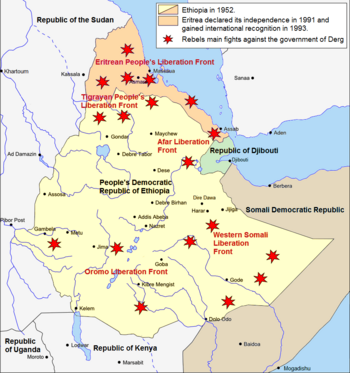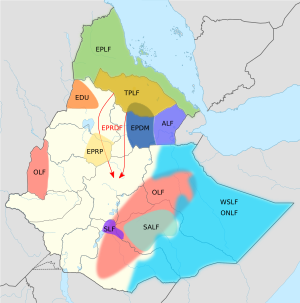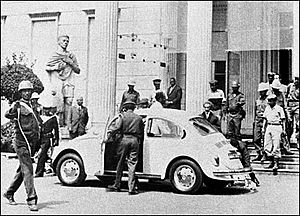Ethiopian Civil War facts for kids
Quick facts for kids Ethiopian Civil War |
|||||||||
|---|---|---|---|---|---|---|---|---|---|
| Part of the conflicts in the Horn of Africa and the Cold War | |||||||||
 Military situation during the Ethiopian Civil War |
|||||||||
|
|||||||||
| Belligerents | |||||||||
|
EPRDF
|
Supported by: |
||||||||
| Commanders and leaders | |||||||||
| Strength | |||||||||
| Casualties and losses | |||||||||
| Casualties and impact of the Ethiopian Civil War | |||||||||
| ~400,000–579,000 killed ~1,200,000 deaths from famine |
|||||||||
The Ethiopian Civil War was a long and difficult conflict in Ethiopia and what is now Eritrea. It lasted from September 12, 1974, to May 28, 1991. The war was fought between the Ethiopian military government, known as the Derg, and different groups of rebels. These rebels wanted to change the government or gain independence for their regions.
The Derg took control of Ethiopia in 1974 by overthrowing Emperor Haile Selassie. They made Ethiopia a Marxist-Leninist country ruled by the military. Many groups disagreed with the Derg's rule. Some were communists themselves, others were against communism, and many were based on different ethnic groups. Eritrean groups were also fighting for their independence.
The Derg tried to stop the rebels with military force and a violent campaign called the Qey Shibir. By the mid-1980s, Ethiopia faced huge problems like a terrible famine and a struggling economy. These issues made more people support the rebels. The Soviet Union, which had supported the Derg, started to pull back its help.
In May 1991, the Derg government was defeated. Its leader, Mengistu Haile Mariam, fled the country. The war officially ended on May 28, 1991, when the main rebel group, the Ethiopian People's Revolutionary Democratic Front (EPRDF), took over the capital city, Addis Ababa. After the war, Eritrea became an independent country, and Ethiopia formed a new government. The civil war caused the deaths of at least 1.4 million people, with many dying from famine.
Contents
Why the War Started
Unrest in Ethiopia
Before the war, the Ethiopian Empire was becoming very unstable. Emperor Haile Selassie had ruled for a long time, but many people were unhappy. Their daily lives were not improving, and the country's economy was growing very slowly. There were also concerns about human rights.
Even though Emperor Selassie tried to modernize Ethiopia, his changes did not work well. His rule seemed to keep an old system where rich nobles had too much power. These nobles often stopped his reforms. In 1960, some politicians and military officers tried to overthrow him. They wanted to create a better government, but their attempt failed. This meant the old problems continued.
Key Events of the War
The Ethiopian Revolution
On September 12, 1974, Emperor Haile Selassie was overthrown by a group called the Derg. The Derg was made up of lower-ranking officers and soldiers from the Ethiopian Army. They became the new military rulers of Ethiopia.
In March 1975, the Derg officially ended the monarchy. They decided to follow Marxism–Leninism, a type of communism. They aimed to build a socialist country in Ethiopia. The Emperor's son went to live in London, and other royal family members in Ethiopia were put in prison. Emperor Haile Selassie himself died in August 1975 while in detention.
The Derg took control of many businesses and private properties. They seized the royal family's wealth. This was part of their plan to make Ethiopia a socialist state.
The Red Terror Campaign
The Derg did not fully control the country at first. Many groups started to challenge their power. The Ethiopian government was already fighting Eritrean groups who wanted independence. Now, new rebel groups appeared. These included groups who supported the old monarchy and other Marxist-Leninist groups.
In 1976, the Derg started a violent campaign called the Qey Shibir (Ethiopian Red Terror). This campaign aimed to crush their opponents, especially the Ethiopian People's Revolutionary Party (EPRP). The violence increased in 1977 when Mengistu Haile Mariam became the leader of the Derg.
This period saw brutal fighting in cities. People were executed, assassinated, tortured, and imprisoned without fair trials. By August 1977, many rebel leaders were killed or forced to flee. However, the Derg still struggled to gain full control. Many innocent people were caught in the violence, which made more Ethiopians support the rebel groups.
The Ogaden War
In July 1977, the Ogaden War began. Somalia invaded Ethiopia to take control of the Ogaden region, which had many Somali people. Somalia's leader, Siad Barre, claimed that only "volunteers" from Somalia were helping the local rebels.
Ethiopia, under the Derg, became a close ally of the Soviet Union. It received a lot of military help from countries like the Soviet Union, Cuba, and North Korea. With this strong support, Ethiopia was able to defeat the Somali army by March 1978. However, this war used up many valuable resources for Ethiopia.
Struggles in the 1980s

The Derg tried to bring in socialist ideas, like giving land to farmers. But poor management, corruption, and the ongoing war caused food production to drop. Ethiopia often faces droughts, but the famine in the mid-1980s was especially bad. It is estimated that 400,000 to 590,000 people died.
Hundreds of thousands of Ethiopians fled the country because of poverty, forced military service, and political oppression. This created the first large Ethiopian communities living outside the country. Rebellions against the Derg grew stronger, especially in the northern regions of Tigray and Eritrea, where people wanted independence.
The Derg continued to fight the rebels with military campaigns. However, they suffered a major defeat in the Battle of Shire in 1989. This battle weakened the Derg's power and helped lead to Eritrea's independence.
The End of the War in the 1990s
In May 1991, the Derg government was finally overthrown. Its own officials and a group of rebel forces, the Ethiopian People's Revolutionary Democratic Front (EPRDF), marched towards the capital, Addis Ababa. The leader, Mengistu, fled to Zimbabwe.
The Derg government lasted only one more week after Mengistu left. The EPRDF then entered and captured Addis Ababa. The EPRDF quickly dissolved the Derg's political party and arrested many of its top officials. Later, in 2006, many Derg officials were found responsible for the violence that occurred during their rule. These events marked the end of socialist rule in Ethiopia. Ethiopia then moved towards a federal democracy, aiming to represent its many different ethnic groups.
Impact of the War
The Ethiopian Civil War had a huge impact on the country. At least 1.4 million people died. About 1 million of these deaths were due to famine, and the rest were from fighting and other violence. This was a significant portion of the population.
The war also affected the land and farming. While land was given to farmers, mismanagement and constant conflict led to a big drop in food production. The country faced severe soil erosion, which further reduced its ability to grow crops. During the 1983–1985 famine, ten million people were affected, which was five times more than a previous drought.
Major Battles of the War
- 1974 Battle of Tirro
- 1977 First Battle of Massawa
- 1977 Siege of Barentu
- 1977–1978 Battle of Jijiga
- 1978 Battle of Harar
- 1988 Battle of Afabet, March 17–20
- 1988 Battle of Shire (1989), December 28, 1988 – February 19, 1989
- 1990 Second Battle of Massawa, February 8–10
Images for kids
-
Senior Derg members Mengistu Haile Mariam, Tafari Benti, and Atnafu Abate.
See also
 In Spanish: Guerra civil etíope para niños
In Spanish: Guerra civil etíope para niños
- Neftenya
- Second Afar Insurgency



